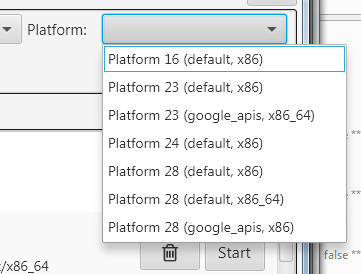Hello JohnK, thank you very much for your answer.
I am trying to launch avdmanager.bat from the desktop, but it gives me some error that I can not solve, although as you say right I think it is posible.
Assuming the following:
AvdManager folder (Android Studio running) ::
D:\0000AndroidEstudio\Componentes\tools\bin\avdmanagerRun.bat
Java folder (B4a running) ::
C:\Program Files\Java\jdk1.8.0_144\bin\javac.exe
I create Symbolic Link (As you indicate me) ::
mklink /D /J D:\java "C:\Program Files\Java\jdk1.8.0_144\bin"
Modify avdmanagerRun.bat adding to the start ::
set JAVA_HOME=D:\java
When I run as administrator "avdmanagerRun.bat" the system responds:
Error: main class java.se.ee not found or loaded
My question is:
Have you managed to launch avdmanager.bat from the command line and it has worked for you?
Could you indicate the modifications you have made step by step in order to replicate them and make it work for me?
Attached response of the system command
D:\0000AndroidEstudio\Componentes\tools\bin>avdmanagerRun.bat
D:\0000AndroidEstudio\Componentes\tools\bin>set JAVA_HOME=C:\Program Files\Java\jdk1.8.0_144\bin
D:\0000AndroidEstudio\Componentes\tools\bin>if "Windows_NT" == "Windows_NT" setlocal
D:\0000AndroidEstudio\Componentes\tools\bin>set DIRNAME=D:\0000AndroidEstudio\Componentes\tools\bin\
D:\0000AndroidEstudio\Componentes\tools\bin>if "D:\0000AndroidEstudio\Componentes\tools\bin\" == "" set DIRNAME=.
D:\0000AndroidEstudio\Componentes\tools\bin>set APP_BASE_NAME=avdmanagerRun
D:\0000AndroidEstudio\Componentes\tools\bin>set APP_HOME=D:\0000AndroidEstudio\Componentes\tools\bin\..
D:\0000AndroidEstudio\Componentes\tools\bin>set JAVA_OPTS=-XX:+IgnoreUnrecognizedVMOptions --add-modules java.se.ee
D:\0000AndroidEstudio\Componentes\tools\bin>set DEFAULT_JVM_OPTS="-Dcom.android.sdkmanager.toolsdir=D:\0000AndroidEstudio\Componentes\tools\bin\\.."
D:\0000AndroidEstudio\Componentes\tools\bin>if defined JAVA_HOME goto findJavaFromJavaHome
D:\0000AndroidEstudio\Componentes\tools\bin>set JAVA_HOME=C:\Program Files\Java\jdk1.8.0_144\bin
D:\0000AndroidEstudio\Componentes\tools\bin>set JAVA_EXE=C:\Program Files\Java\jdk1.8.0_144\bin/java.exe
D:\0000AndroidEstudio\Componentes\tools\bin>if exist "C:\Program Files\Java\jdk1.8.0_144\bin/java.exe" goto init
D:\0000AndroidEstudio\Componentes\tools\bin>if not "Windows_NT" == "Windows_NT"goto win9xME_args
D:\0000AndroidEstudio\Componentes\tools\bin>set CMD_LINE_ARGS=
D:\0000AndroidEstudio\Componentes\tools\bin>set _SKIP=2
D:\0000AndroidEstudio\Componentes\tools\bin>if "x" == "x" goto execute
D:\0000AndroidEstudio\Componentes\tools\bin>set CLASSPATH=D:\0000AndroidEstudio\
Componentes\tools\bin\..\lib\dvlib-26.0.0-dev.jar;D:\0000AndroidEstudio\Componen
tes\tools\bin\..\lib\jimfs-1.1.jar;D:\0000AndroidEstudio\Componentes\tools\bin\.
.\lib\jsr305-1.3.9.jar;D:\0000AndroidEstudio\Componentes\tools\bin\..\lib\reposi
tory-26.0.0-dev.jar;D:\0000AndroidEstudio\Componentes\tools\bin\..\lib\j2objc-an
notations-1.1.jar;D:\0000AndroidEstudio\Componentes\tools\bin\..\lib\layoutlib-a
pi-26.0.0-dev.jar;D:\0000AndroidEstudio\Componentes\tools\bin\..\lib\gson-2.3.ja
r;D:\0000AndroidEstudio\Componentes\tools\bin\..\lib\httpcore-4.2.5.jar;D:\0000A
ndroidEstudio\Componentes\tools\bin\..\lib\commons-logging-1.1.1.jar;D:\0000Andr
oidEstudio\Componentes\tools\bin\..\lib\commons-compress-1.12.jar;D:\0000Android
Estudio\Componentes\tools\bin\..\lib\annotations-26.0.0-dev.jar;D:\0000AndroidEs
tudio\Componentes\tools\bin\..\lib\error_prone_annotations-2.0.18.jar;D:\0000And
roidEstudio\Componentes\tools\bin\..\lib\animal-sniffer-annotations-1.14.jar;D:\
0000AndroidEstudio\Componentes\tools\bin\..\lib\httpclient-4.2.6.jar;D:\0000Andr
oidEstudio\Componentes\tools\bin\..\lib\commons-codec-1.6.jar;D:\0000AndroidEstu
dio\Componentes\tools\bin\..\lib\common-26.0.0-dev.jar;D:\0000AndroidEstudio\Com
ponentes\tools\bin\..\lib\kxml2-2.3.0.jar;D:\0000AndroidEstudio\Componentes\tool
s\bin\..\lib\httpmime-4.1.jar;D:\0000AndroidEstudio\Componentes\tools\bin\..\lib
\annotations-12.0.jar;D:\0000AndroidEstudio\Componentes\tools\bin\..\lib\sdklib-
26.0.0-dev.jar;D:\0000AndroidEstudio\Componentes\tools\bin\..\lib\guava-22.0.jar
D:\0000AndroidEstudio\Componentes\tools\bin>"C:\Program Files\Java\jdk1.8.0_144\
bin/java.exe" "-Dcom.android.sdkmanager.toolsdir=D:\0000AndroidEstudio\Component
es\tools\bin\\.." -XX:+IgnoreUnrecognizedVMOptions --add-modules java.se.ee -c
lasspath "D:\0000AndroidEstudio\Componentes\tools\bin\..\lib\dvlib-26.0.0-dev.ja
r;D:\0000AndroidEstudio\Componentes\tools\bin\..\lib\jimfs-1.1.jar;D:\0000Androi
dEstudio\Componentes\tools\bin\..\lib\jsr305-1.3.9.jar;D:\0000AndroidEstudio\Com
ponentes\tools\bin\..\lib\repository-26.0.0-dev.jar;D:\0000AndroidEstudio\Compon
entes\tools\bin\..\lib\j2objc-annotations-1.1.jar;D:\0000AndroidEstudio\Componen
tes\tools\bin\..\lib\layoutlib-api-26.0.0-dev.jar;D:\0000AndroidEstudio\Componen
tes\tools\bin\..\lib\gson-2.3.jar;D:\0000AndroidEstudio\Componentes\tools\bin\..
\lib\httpcore-4.2.5.jar;D:\0000AndroidEstudio\Componentes\tools\bin\..\lib\commo
ns-logging-1.1.1.jar;D:\0000AndroidEstudio\Componentes\tools\bin\..\lib\commons-
compress-1.12.jar;D:\0000AndroidEstudio\Componentes\tools\bin\..\lib\annotations
-26.0.0-dev.jar;D:\0000AndroidEstudio\Componentes\tools\bin\..\lib\error_prone_a
nnotations-2.0.18.jar;D:\0000AndroidEstudio\Componentes\tools\bin\..\lib\animal-
sniffer-annotations-1.14.jar;D:\0000AndroidEstudio\Componentes\tools\bin\..\lib\
httpclient-4.2.6.jar;D:\0000AndroidEstudio\Componentes\tools\bin\..\lib\commons-
codec-1.6.jar;D:\0000AndroidEstudio\Componentes\tools\bin\..\lib\common-26.0.0-d
ev.jar;D:\0000AndroidEstudio\Componentes\tools\bin\..\lib\kxml2-2.3.0.jar;D:\000
0AndroidEstudio\Componentes\tools\bin\..\lib\httpmime-4.1.jar;D:\0000AndroidEstu
dio\Componentes\tools\bin\..\lib\annotations-12.0.jar;D:\0000AndroidEstudio\Comp
onentes\tools\bin\..\lib\sdklib-26.0.0-dev.jar;D:\0000AndroidEstudio\Componentes
\tools\bin\..\lib\guava-22.0.jar" com.android.sdklib.tool.AvdManagerCli
Error: no se ha encontrado o cargado la clase principal java.se.ee
D:\0000AndroidEstudio\Componentes\tools\bin>if "1" == "0" goto mainEnd
D:\0000AndroidEstudio\Componentes\tools\bin>rem Set variable AVDMANAGER_EXIT_CONSOLE if you need the _script_ return code instead of
D:\0000AndroidEstudio\Componentes\tools\bin>rem the _cmd.exe /c_ return code!
D:\0000AndroidEstudio\Componentes\tools\bin>if not "" == "" exit 1
D:\0000AndroidEstudio\Componentes\tools\bin>exit /b 1
D:\0000AndroidEstudio\Componentes\tools\bin>




